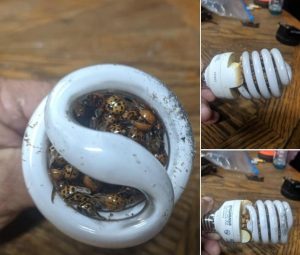In the autumn of 2019, a man named Jason Whitaker from Kentucky experienced a terrifying incident that nearly cost him his home. What started as a normal day quickly turned into a moment of panic when he noticed an unusual burning smell in his house. At first, Jason thought it might be coming from a faulty wire or perhaps an overloaded electrical outlet. As someone who’s generally cautious about home maintenance, he immediately began inspecting each room in his house, trying to locate the source of the odor before it escalated into something more serious. What he discovered left him shocked and alarmed—not only for himself but for countless others who might unknowingly face the same danger.

After thoroughly checking his appliances and electrical outlets and finding nothing out of the ordinary, he turned his attention upward—to the lighting fixtures in his home. That’s when he discovered something disturbing. One of his spiral-shaped compact fluorescent light (CFL) bulbs, which had been in use for several years, was the source of the smell. But it wasn’t just a matter of the bulb wearing out. Upon closer inspection, Jason saw that the bulb had become infested with ladybugs. Somehow, over time, the insects had crawled into the bulb’s spiral design and gotten trapped inside. As the bulb heated up during use, the accumulation of dead insects and debris created the perfect environment for combustion, turning what was supposed to be an energy-efficient lighting solution into a serious fire hazard.
Jason was fortunate to have caught the issue in time. He managed to remove the bulb and clean the fixture before any actual flames ignited, but he knew that others might not be so lucky. Realizing the potential danger this type of situation could pose to households across the country, he decided to share his experience on social media in hopes of preventing future incidents. He posted a detailed warning on Facebook, complete with photos of the bulb and an explanation of what had happened. His message was simple: be cautious with spiral CFL bulbs, especially older ones, and take the time to inspect them regularly.
What Jason didn’t anticipate was just how widespread this issue might be. His post went viral almost immediately, amassing over 430,000 shares within days. People from across the United States and even from other countries began commenting and sharing their own experiences. Many mentioned finding insects, dust, and other debris lodged in their spiral bulbs. Some even reported that their bulbs had already shown signs of overheating or had suddenly stopped working. The common thread in all of these reports was that the spiral design of the CFL bulbs, while efficient for lighting, also created small spaces that were difficult to clean and could attract unwanted pests like ladybugs or spiders.
Jason’s warning struck a chord with homeowners, renters, and even electricians who had seen similar cases in their professional work. Some experts weighed in on the conversation, noting that while CFL bulbs are designed to be energy-efficient and have long lifespans, they’re not immune to external factors like insect infestation or dust buildup. In fact, the compact, tightly wound design that makes them unique can also make them more susceptible to trapping particles and critters. When these foreign elements are exposed to consistent heat, they can become combustible, especially if the bulb is near flammable materials like curtains or wood paneling.
As awareness of this hidden danger grew, many people began taking action. Some replaced their CFL bulbs with LED alternatives, which have a different structure and are generally considered safer. Others inspected every light fixture in their home, removing and cleaning out spiral bulbs that had been in place for years. A few even took the extra step of installing protective covers or screens over light fixtures to prevent insects from crawling in.
For Jason, the response was overwhelming and humbling. What started as a simple Facebook post meant to alert a few friends and neighbors had turned into a nationwide safety campaign. He received messages of thanks from people who were grateful to have avoided potential disasters in their own homes. Parents expressed relief that they could now take steps to protect their children, and elderly homeowners thanked him for raising awareness about something they never would have thought to check.
The story serves as a powerful reminder that sometimes, small things can have huge consequences. A light bulb—a basic item in every household—can pose a real threat if not monitored properly. While it’s easy to overlook something as ordinary as a bulb, Jason’s experience shows that vigilance, even in the smallest areas of home maintenance, can make a life-saving difference.
Home safety is often about prevention. It’s about catching a problem before it becomes a crisis. Checking your light bulbs might not seem like a priority when compared to more obvious tasks like locking doors or checking smoke detectors. But as this case shows, it only takes a few moments of attention to prevent what could become a devastating fire.
So what should homeowners take away from Jason’s story? First, if you’re still using CFL bulbs—especially ones that have been installed for several years—it’s worth taking a closer look. Remove the bulb, inspect the base, and check for any signs of buildup or infestation. If you notice anything unusual, replace it immediately. Consider switching to LED lighting, which not only uses less energy but also has a more enclosed design that’s less likely to attract bugs or trap particles.
Second, make it a habit to regularly inspect all light fixtures in your home. Dust, insects, and even small nests can accumulate in places you might never think to check. Adding this step to your seasonal cleaning routine can reduce your risk of fire and give you peace of mind.
Lastly, share what you learn. Just like Jason did, spreading the word can make a big difference. You never know whose home or life might be saved by a simple reminder to check a light bulb.
This cautionary tale reminds us all that sometimes, staying safe is as easy as looking up. Stay alert, stay safe—and don’t underestimate the power of small actions.





